Adam Larson
Caustic Logic / The Frustrating Fraud
January 8 2007
last updated 12/9/07
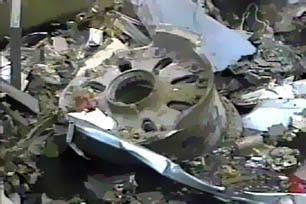 |
The picture at left was taken by an unknown photographer on September 12 and shown in a The Learning Channel documentary. The location is in the Pentagon’s A-E Drive, at the far end of the plane’s trajectory between rinds B and C, just outside the curious 'punch-out' exit hole. It’s of a wheel rim generally thought to be from Flight 77. No missile I know of uses landing gear with wheels, but smaller planes do, and debate has raged over whether or not this is the precisely and verifiably a 757’s wheel or from something smaller.
Karl Schwarz, among his information that was “hand-delivered to New York Attorney General Eliot Spitzer,” decided the wheel is “the type made by B.F. Goodrich in their aerospace division. They also made the wheels for the 757 but a simple proportional check of width versus diameter will easily show that the below photo is not of a wheel hub from a 757 [...] This radius being about the same as the width of the wheel hub is also another clue that the 757 story is a Bush Lie." To clue us in on the truth, he noted that this looks like an A3 Skywarrior wheel - if it had the wrong wheels. "This is the type of wheel hub one would expect to find as one of the two rear wheels on an A-3 refitted with current equipment rather than equipment that is no longer being manufactured." [source]
 |
Another point I recall seeing made at LetsRoll 911 was the difference in the holes placed radially around the center mount. Both seem to have a symmetrical arrangement but a differing number – the Pentagon rim with eight, the intact gear sporting ten, it seems. This is not so odd though, as Russell Pickering found out with some research, the 757-200 series (which Flight 77 was) uses precisely two different types interchangably - "one with 10 slots and one with 8." It's hard to say which type FLight 77 was equipped with, since, as Pickering found, "airlines are not obligated to use the same rim and gear manufacturer on a particular aircraft.” [source] My guess is it had eight holes. In fact the debunkers at Aerospaceweb.org found a photo showing the very craft in question - tail number N644AA - sporting main gear wheels with eight slots, just like the one that wound up in the drive. If it was planted, it was done right. But where are the other seven main gear wheels? Or the two nose gear wheels?
More Wheels
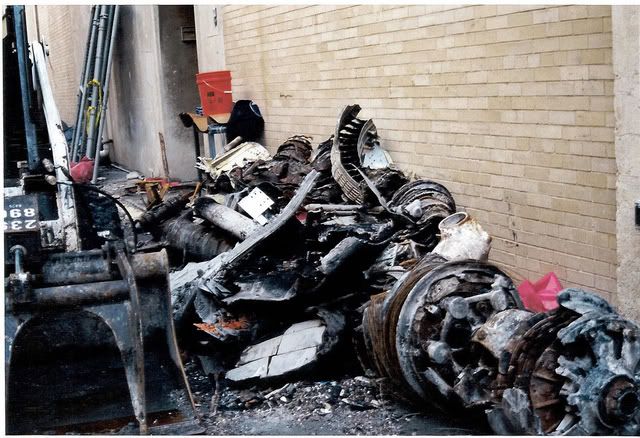
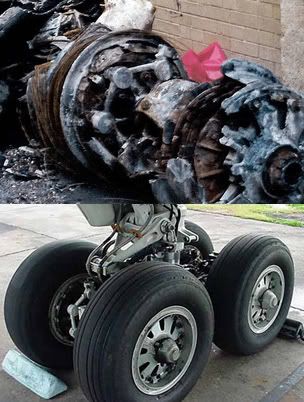 Above is a photo first published back in September. I first found it at the Loose Change Forum (halfway down page), posted by LCF member Digest, who had just re-deployed, to Iraq I would guess. Additional details remain hazy, but it would seem to be in the A-E Drive as well, and shows some apparent engine parts as well as a glimpse of the main gear strut (which I'll discuss in a moment) and a main gear wheel assembly with two battered wheels attached that seem to match the TLC wheel. Compare this with the main gear seen on a 757 (left).
Above is a photo first published back in September. I first found it at the Loose Change Forum (halfway down page), posted by LCF member Digest, who had just re-deployed, to Iraq I would guess. Additional details remain hazy, but it would seem to be in the A-E Drive as well, and shows some apparent engine parts as well as a glimpse of the main gear strut (which I'll discuss in a moment) and a main gear wheel assembly with two battered wheels attached that seem to match the TLC wheel. Compare this with the main gear seen on a 757 (left). The Strut(s)
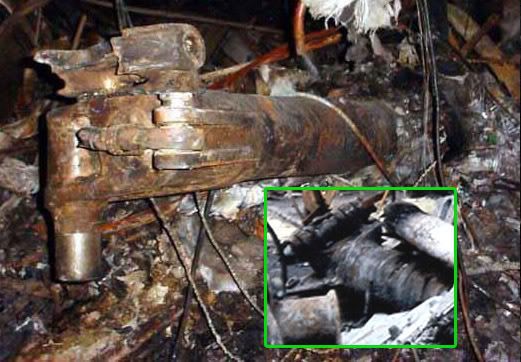
Then we can see what had once attached this wheel to the plane, a massive hydraullic leg found in the C Ring just inside the exit hole – not far from the wheel. This appears to be one of two main landing gear struts. Pickering wasn’t at first sure of the size of this clearly hydraulic artifact. He speculated it might be something from inside the building, like “the cylinder from a trash compactor,” but noted “if it could be proven that it was from an aircraft other than a 757 [that] would obviously be significant.” The inset is from the photo above - it bears the same hallmarks, and could be either the same strut or its counterpart.
 Then he located another photo that clarified the scale of the thing, filling much of a room, as seen above, and compared this shot with a photo of a 757 landing gear in the shop, which Pickering obtained and I’ve superimposed for human scale. Taken together, these led Pickering to conclude “it must be a landing gear,” and its trunion link layout and other clues strongly suggesting a 757's. [source] Some scientists interviewed for the Dutch TV program Zembla were shown these photos [video link - 1:50 mark] and decided it was likely from a 757.
Then he located another photo that clarified the scale of the thing, filling much of a room, as seen above, and compared this shot with a photo of a 757 landing gear in the shop, which Pickering obtained and I’ve superimposed for human scale. Taken together, these led Pickering to conclude “it must be a landing gear,” and its trunion link layout and other clues strongly suggesting a 757's. [source] Some scientists interviewed for the Dutch TV program Zembla were shown these photos [video link - 1:50 mark] and decided it was likely from a 757. Whatever the merits of the too-small wheel analysis, after reviewing this massive, fundamental, and highly likely 757 part buried in the wreckage, any further discussion of the precise type of wheel at the end of it would now seem doubly ludicrous. All the HTB people have left now is the contention that these photos were stage-managed, the parts planted, or complete CGI forgeries. And they probably will make that case, if they bother acknowledging this evidence at all, as well as that the wheel in the forgeries is far too small. But for those who rely exclusively on evidence like Loose Change, Pentagon Strike, In Plane Site, or Painful Deceptions, the solution is simple - they will never be confronted with the landing gear photo, which was excluded from all these in-depth videos for some reason.
The Tire/Gear At Impact

Additionally, a single large tire - or at least half of one - was seen in the A-E Drive, in close proximity to the wheel found there. It is not pristine, but relatively intact for having passed through 300 feet of building. Perhaps this has to with being shielded by the rest of the plane. Of all eyewitness reports, only Noel Sepulveda recalls the landing gear down before the plane impacted. Other witnesses specifically report the landig gear was NOT extended at impact. William Lagasse: "The 757’s flaps were not deployed and the landing gear was retracted." [fifteen corroborating accounts compiled by Arabesque], and so remained safely tucked within the plane's underside, presumably until the fusealge came apart around it.
What We've Seen
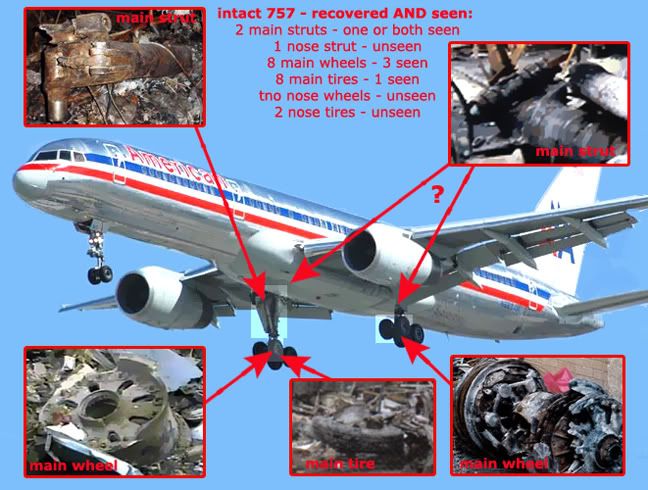
What we've seen is actuall a decent percentage of the landing gear, mostly just inside and outside the 'punch-out' hole which was semi-officially caused by some unspecified part of the Landing gear. One massive main strut apparently came to rest inside this opening, perhaps the same one was later photographed outside in the drive, along with the two wheel segment, which may well have been pulled out from inside. All of the gear we can identify as likely exiting the building on its own is that lone piddly wheel and tire, photographed from the beginning on the pile of rubble fanning out from the hole. The rest of the gear not shown on this page, if it was there at all, was buried somewhere inside that high-security installation and not publicly shown yet to my knowledge. One sobering possibility that should be considered is whether perhaps the smaller, unseen nose gear had detached early on, in its folded and dense postion, and buried itself nearly intact in a victim's torso. Would this photo be released if so? I actually hope not.
Sources:
[1] Schwarz, Karl W. B. “Pop goes the Bush mythology bubble Part 5: Exploding the myth of the Bushes as an all-American family.” Online Journal, via www.karlschwarz.com/02-02-05_Schwarz.pdf
[2] “Loose Change, section two: The Wheel Hub.” Internet Detectives. http://internetdetectives.biz/case/loose-change-2#the-wheel-hub









No comments:
Post a Comment